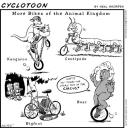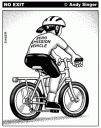 1) If they don’t stop pedalling. This might sound simple enough, but most recreational cyclists stop pedalling for vast periods of time to rest their legs. Meanwhile, cyclists on a misson keep their cadence constant the whole time.
1) If they don’t stop pedalling. This might sound simple enough, but most recreational cyclists stop pedalling for vast periods of time to rest their legs. Meanwhile, cyclists on a misson keep their cadence constant the whole time.
2) They are riding a bike with double chainrings and not a triple chainring or compact crankset.
3) One way to estimate distance that someone has cycled is by looking at the amount of water they’re carrying. Two 750ml bottles and they’re out for a few hours. Two 750ml bottles + a 2L camelback, and they’re doing some serious training mileage. How can I be so certain? ‘Cause no one carries that extra weight unless they need to. 😉
4) They’ve shaved or waxed their legs. A lot of good cyclists do this for many reasons. Foremost, because it looks good. Second, because it feels good. Third, because if you crash, you don’t create a very painful composite (human hair fibres in a blood matrix). If they’re really good they’ll shave their arms too!
5) They’ve left their leg hairs grow proudly. (that’s right, the presence of leg hairs is never a true indication of the fitness of an individual)
6) They’ve got mis-matched tyres. Why? Because it means they can’t be fussed with th look of their bike. They’d rather be out cycling than waiting or looking around for a new pair of same-brand tires.
7) A far better way to tell if they are a decent rider is to see if they use genuine cycling socks… white for road, black for MTB.
8) They’re out cycle-training in Tenerife… because there are no easy rides here.
9) They’ve got tattoos. Because everyone knows that tats are associated with drug-use and they’re probably taking EPO.
10) They’re passing you as you note all of the above.
Tags: Learning Curve by Dr. Leslie Brown
No Comments »
 Not so much a review, this is just my first riding impressions of SRAM’s new Rival shifters for 2009. Several things bugged be enough to write this article:
Not so much a review, this is just my first riding impressions of SRAM’s new Rival shifters for 2009. Several things bugged be enough to write this article:









